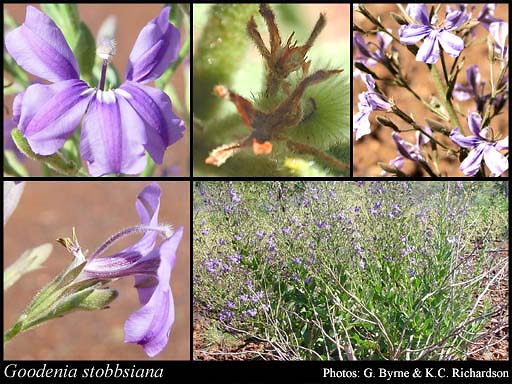- Reference
- Fragm. (Mueller) 11:49 (1878)
- Conservation Code
- Not threatened
- Naturalised Status
- Native to Western Australia
- Name Status
- Current
Prostrate or erect, much-branched, viscid shrub, 0.4-1 m high. Fl. blue, Mar to Oct. Stony soils.

Scientific Description
Stems ribbed. Leaves flat, 25-110 mm long, 7-35 mm wide, Indumentum present, with sparse, glandular hairs; margins entire or toothed. Bracteoles present, 4-5.5 mm long, hairy, with glandular hairs. Pedicel pedicellate, Pedicel length the pedicels 15-25 mm long, Indumentum present, Hair type with glandular hairs. Calyx lobes present, Calyx length 3-5 mm long, hairy, with dense, glandular hairs. Corolla blue, 20-24 mm long, without auricles, not spurred, hairy on the outside, with sparse, glandular hairs, glabrous on the inside; central lobes 7-11 mm long, with wings; outer lobes 9-15 mm long, wing present on both sides and clearly unequal, 1.5-2 mm wide on the narrower side, 2.5-3 mm wide on the broader side. Anthers free. Ovary inferior, not gibbose; style 13-17 mm long, hairy; indusium single, hairy; ovules more than two. Flowers in March, April, May, June, July, August, September and October. Occurs in the Pilbara (PIL), Carnarvon (CAR), Gascoyne (GAS), Great Sandy Desert (GSD), Little Sandy Desert(LSD) and Dampier land (DL) IBRA Region(s), of the Northern (N) and Eremaean (E) Botanical Province.
Distribution
- IBRA Regions
- Carnarvon, Gascoyne, Great Sandy Desert, Little Sandy Desert, Ord Victoria Plain, Pilbara.
- IBRA Subregions
- Ashburton, Cape Range, Chichester, Fortescue, Hamersley, Mackay, McLarty, Roebourne, Rudall, South Kimberley Interzone, Trainor.
- IMCRA Regions
- Canning, Pilbara (nearshore).
- Local Government Areas (LGAs)
- Ashburton, Broome, Derby-West Kimberley, East Pilbara, Karratha, Port Hedland, Upper Gascoyne, Wiluna.